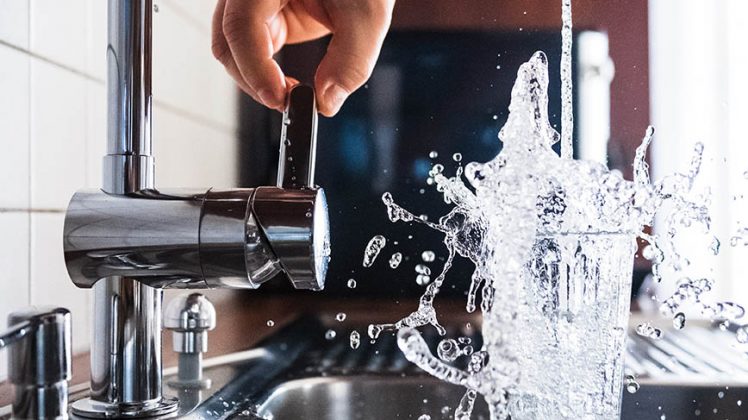
Climate change has contributed to Sweden experiencing water shortages in many provinces in recent years, and continued challenges with rampant climate change are likely to further accelerate this problem. In many other countries, the problem of water scarcity is much more pronounced. The UN report “World Water Development Report 2020, Water and Climate Change” describes a gloomy picture of the water situation in the world, e.g. As many as 2.2 billion people do not have access to drinking water. The UN warns that climate change will exacerbate this situation if measures are not taken in this area. Access to clean water and sanitation for all is one of the UN’s global goals (SDG6). Achieving these goals requires a restructuring of society’s infrastructure. The increasing water shortage will lead to more advanced treatment methods having to be used to produce our drinking water with an increased energy need for water treatment in society.
In the built environment, large amounts of drinking water are used for various purposes, such as hot water for shower, bath, and sink, but also for other functions such as toilet flushing and lawn watering. Significant amounts of energy, chemicals, water, and financial resources are required to maintain this system. As an example, around 11 TWh is used annually for heating domestic hot water in villas, apartment buildings and premises in Sweden, corresponding to an estimated cost of SEK 10 billion annually (Energy Situation 2020, STEM). Of these 11 TWh, the entire 3.5 TWh loads the electricity grid. In addition to this massive energy demand, domestic hot water heating drives up the power demand in society’s infrastructure for energy supply, which entails major challenges for both energy producers and grid owners.
It is interesting that only a small part of the water used in society today is used for functions that require the relatively high quality of drinking water. The remaining amount of water is used for other purposes such as toilet flushing, shower, dishes, laundry.
By recycling and managing most of this cycle locally at building or area level, the water system would be more resource efficient, partly from an energy and power perspective, partly from a water supply and use perspective. Thus, to increase resource efficiency in this area, water can be used better and in a more sustainable way if water can be recycled and heat recovery is introduced on a broad front.
How this can be done in the best way is not clear, today there are a number of different system solutions with different technical maturity levels. For these types of systems solutions to succeed in the society, interdisciplinary research is required.
Pressure from property owners, planners and construction companies regarding sustainable water systems already exists today, driven partly by energy requirements and partly by the environment and environmental certification requirements. Even though innovative system solutions are in demand, there are no complete solutions available due to that knowledge of opportunities is lacking.
This new project, to be executed by doctorial student Viktor La Torre Rapp and supervised by Dr Jörgen Wallin (KTH) and Dr Jesper Knutsson (CTH), aim to identify which solutions, recycling solutions or recycling solutions with associated system structures provide the best conditions for meeting the challenges identified regarding water supply in society.
The goal is to present which possible system solutions and methods are conceivable for implementation at different levels in the built environment from a life cycle perspective and which are not based on a list of criteria that cover aspects in regulation, acceptance, economy, environment, and health. This presentation should include an account of the identified solutions, how the overall financial picture is compared to current technology with maintenance costs included. A reference group consisting of property owners, planners and construction companies as well as water suppliers and producers will join in order to optimize the use of the outcome and enhance the implementation of possible solutions.
During the project one or more selected promising solutions will be implemented and validated in test beds, HSB Living Lab In Gothenburg and KTH Live in Lab in Stockholm.
The project is funded by E2B2 and will take place during 2021-2024.
Viktor La Torre Rapp, Doctoral Student, Dept. of Energy Technology, KTH School of Industrial Engineering and Management

